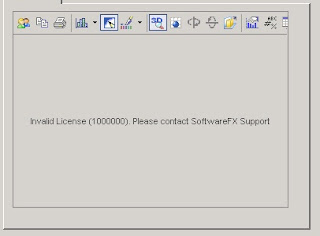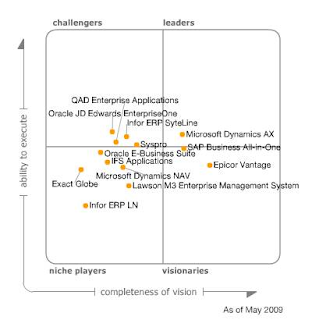Friday, June 26, 2009
Email from Ax by CLR interop
Here's another example. This time, we are going to send an email from Ax with it. (Yes I know, this kind of functionalities are provided with Ax out-of-the-box as well.)
void Email()
{ System.Net.Mail.MailMessage myMailMessage;
System.Net.Mail.SmtpClient myMail;
System.Net.Mail.MailAddress myMailFrom;
System.Net.Mail.MailAddress myMailTo;
System.Net.NetworkCredential myNC;
str mySubject="Mail from Ax 2009";
str myMailBody="The email body goes here";
str myMailFromStr="youremail@yourdomain.com";
str myMailToStr="youremail@yourdomain.com";
str mysmtpServer="yourmailservername";
str mylogin="loginname";
str mypassword="loginpassword";
;
myMailFrom = new System.Net.Mail.MailAddress(myMailFromStr,myMailFromStr);
myMailTo = new System.Net.Mail.MailAddress(myMailToStr,myMailToStr);
myMailMessage = new System.Net.Mail.MailMessage(myMailFrom,myMailTo);
myMailmessage.set_Subject(mySubject);
myMailmessage.set_Body(myMailBody);
myMail = new System.Net.Mail.SmtpClient(mysmtpServer);
myNC= new System.Net.NetworkCredential(mylogin,mypassword);
myMail.set_Credentials(myNC);
myMail.Send(myMailmessage);
}
Supplying of the network credentials is optional. If not specified, the default network credentials will be used. Depending on your email server settings (relay on/off), only emails to the local domain are allowed.
This example can be extended, to include file attachments for example.
Greetingz,
Willy
Network ping command by CLR interop
Here's a small example. It demonstrates the well known ping command, to check if a computer is online.
Parameters are the Ip address (string format like 127.0.0.1) and the timeout.
static boolean Ping(str myIpAddressStr,int myTimeOut=4000)
{ System.Net.NetworkInformation.Ping myPing;
System.Net.NetworkInformation.PingReply myPingReply;
System.Net.IPAddress myIPAddress;
System.Net.NetworkInformation.IPStatus myIpStatus;
str myIPStatusStr;
;
if(!myIpAddressStr)
return false;
myIPAddress = System.Net.IPAddress::Parse(myIPAddressStr);
myPing = new System.Net.NetworkInformation.Ping();
myPingReply=myPing.Send(myIPaddress,myTimeOut);
myIpStatus=myPingReply.get_Status();
myIPStatusStr=myIpStatus.ToString();
if(myIPStatusStr=='Success')
return true;
return false;
}
I'll post some more samples later on.
Greetz,
Willy
Wednesday, June 24, 2009
Chart Object: Invalid license

Friday, June 19, 2009
Terminate a clien session
I can suggest two approaches. Use the first job to kill the session of a specified user id. This involves the use of the xSession class, which I blogged of earlier on.
static void TerminateSession(UserId UserId)
{ xSession xSession;
int xSessionId;
;
xSessionId = (select * from SysClientSessions where SysClientSessions.userId==UserId && SysClientSessions.Status==1).SessionId;
xSession = new xSession(xSessionId);
if (xSession)
xSession.terminate(xSession.loginDate(), xSession.loginTime());
}
If you would like to end the current session by code, you can do it like this:
static void ShutDown(Args _args)
{ Info Info = new Info();
;
Info.shutDown(true);
}
If you can think of other means, feel free to post them in the comments.
Saturday, June 13, 2009
Check to see if a user is logged on
server static boolean isUserOnline(userId userId)
{ xSession session;
int counter;
int maxSessions = Info::licensedUsersTotal();
;
if (!userId)
{
return false;
}
for(counter = 1; counter < session =" new">
This example is a nice illustration for the use of the xSession class.
I came up with an alternative, shorter version for the example above:
server static boolean isUserOnline(userId userId)
{ ;
return (select count(recid) from SysClientSessions where SysClientSessions.userId==UserId && SysClientSessions.Status==1).RecId;
}
So, both functions give you an easy way of checking if a specific user is online in Axapta.
Current session id
So, for example in a job, to show the current session id
static void ClientSessionJob(Args _args)
{ ;
info(strfmt('This client session id is %1',int2str(SessionId())));
}
You can use this function together with the class xSession to collect more info.
The class xSession is responsible for retrieving various session information. Like the logon date and time:
static void LogonDateTime(Args _args)
{ xSession xSession;
;
xSession = new xSession(SessionId());
info(strfmt('The logon date and time were %1',DateTimeUtil::toStr(xSession.loginDateTime())));
}
Or the current AOS server name you're logged onto:
static void CurAOSServerName(Args _args)
{ xSession xSession;
;
xSession = new xSession();
info(strfmt('Current AOS server name logged onto is %1',xSession.AOSName()));
}
Instantiate the class xSession without a session id to get info for the current session.
The user id used to create the session is also available. But there is an alternative for this one:
static void ClientUserId(Args _args)
{ ;
info(strfmt('Current logged on user id %1',curUserId()));
}
Try out for yourself!
Thursday, June 11, 2009
Gartner Magic Quadrant in ERP
Not only does it get a good review, it's also the only product to be in the leader quadrant. Nice!

Gartner sees some trends in the ERP market, like
- industry-specific functionality or verticalization
- globalization, no longer being exclusive for large enterprises
- consolidation in the market of ERP vendors
For both point 1 and 2, you can see Ax has grown the past few years. Offering a wealth of vertical solutions, certified and all. Microsoft also worked on the stability and performance of the product, making Ax even more suited to global operating companies, enterprise size or not. (fe Unicode support, multiple-time zones)
Some points why Ax scored so well in the report:
- the user interface is considered to be very intuitive and easy to learn and use + it's role tailored
- broad range of functionality, both horizontal and vertical
- strong worldwide partner channel, certified
- completeness of vision from Microsoft
- scalable product, easy to customize for both enhancements and proces changes
All in all, a very good report. Nice to know for companies who have invested or are planning to invest in this offering.
You can read more of the report, which includes reviews of products from Oracle, SAP and Microsoft (with Dynamics NAV as well) over here.
Edit:
The report scores well with the press guys at Microsoft. But over the internet, a lot of criticism can be heard. Like on zdnet, cio.com, and The Enterprise System Spectator. They score some good arguments to question the outcome of the report (like no SaaS vendors included).
What can be learned from that? Don't use the Magic Quadrant as a buying guide for products. After all, if the solution you have an eye on has a perfect fit for your functional requirements, what do you care if the vendor has no worldwide presence if your a local operating company? Use the outcome of the report (pro and contra's) and verify them with your own findings/requirements. What are YOU looking for in an ERP suite and how is this evaluated by Gartner?
Wednesday, June 3, 2009
Checking table access from code
boolean CheckSecurityTable(TableId myTableId)
{ SysDictTable SysDictTable;
;
SysDictTable = new SysDictTable(myTableId);
if(SysDictTable.rights()<AccessType::View)
return false;
return true;
}
If you like your code a little more condensed, you could always use the built-in function hastableaccess. For example:
if(hastableaccess(tablenum(SalesLine),AccessType::View))
return true;
Something similar, but now with a menuitem:
boolean CheckSecurityMenu(MenuName myMenuName)
{ SysDictMenu SysDictMenu;
;
SysDictMenu = SysDictMenu::newMenuItem(myMenuName,MenuItemType::Display);
if(SysDictMenu.rights()<AccessType::View)
return false;
return true;
}
Greetz,
Willy
Tuesday, June 2, 2009
Colors in Ax
There are different coding system for colors. Some functions require the hexadecimal format, others expect an integer and so on.
Luckily, Ax comes with some built in functions to do the necessary conversions for you. Like this one:
WinApi::RGB2int() - Convert the red, green and blue values to an integer.
WinApi::RGBCon2int() - Dito, but with a container input
WinApi::RGBInt2con() - The opposite, converting from an integer to separate red, green and blue values
Or create your own functions, like this one for example:
static str int2RGBhex(int color)
{ container colorcon;
str colorhex;
;
colorcon=WinApi::RGBint2Con(color);
colorhex=Global::int2Hex(conpeek(colorcon,1),2);
colorhex+=Global::int2Hex(conpeek(colorcon,2),2);
colorhex+=Global::int2Hex(conpeek(colorcon,3),2);
return colorhex;
}
This function will convert an integer color value to a hexadecimal one.
Happy coding,
Willy

